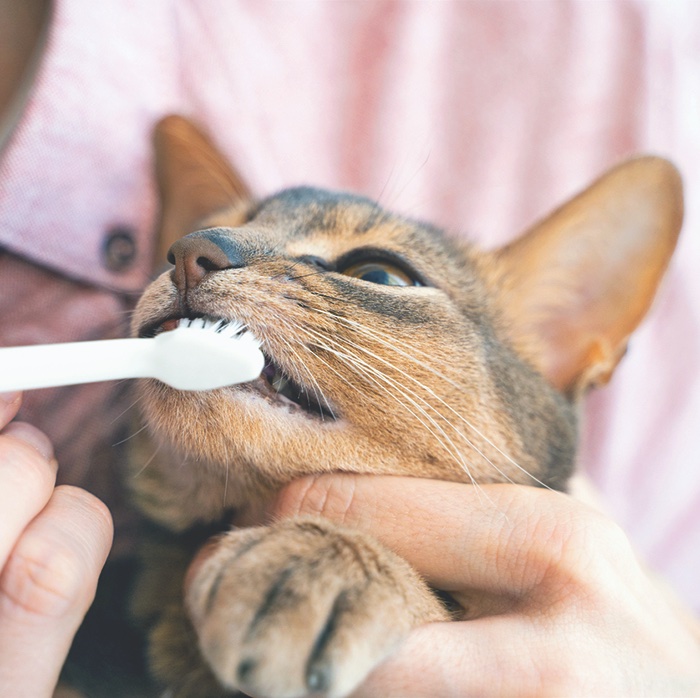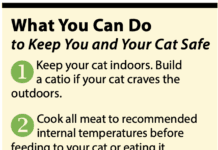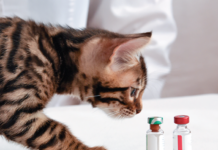Keeping your cat’s mouth clean goes a long way toward keeping her comfortable and healthy for many years. Can you imagine not brushing your teeth or seeing a dentist for 15 years? It wouldn’t be a pretty sight—or smell! Good oral hygiene is just as important for your cat’s health as it is for yours, and keeping your cat’s teeth in good shape helps prevent disease and can save you some costly dental procedures.
The best approach to feline oral hygiene includes a combination of regular professional veterinary dental evaluations and cleanings and a daily home dental-care program, starting as soon as your kitten’s adult teeth are in.
“An annual dental evaluation by a veterinarian is recommended by 3 years of age,” says Dr. Emilia Chrostek, resident in dentistry and oral surgery at the Cornell University Hospital for Animals. “Based on the needs of the patient, a routine periodontal assessment and treatment under general anesthesia will usually be recommended once a year.”
Dental Assessment
“Periodontal assessment and treatment includes dental X-rays,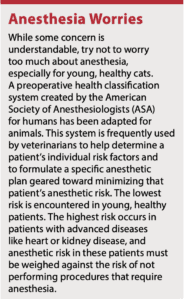 probing and charting of teeth, and ultrasonic cleaning with treatment if needed,” says Dr. Chrostek. “The time for the next periodontal assessment and treatment can be adjusted for each patient, including more frequent assessments for patients that require it.”
probing and charting of teeth, and ultrasonic cleaning with treatment if needed,” says Dr. Chrostek. “The time for the next periodontal assessment and treatment can be adjusted for each patient, including more frequent assessments for patients that require it.”
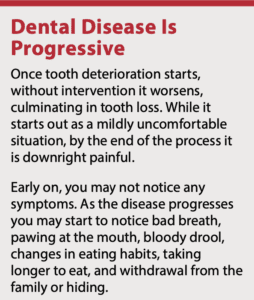 Brushing Teeth
Brushing Teeth
The best home treatment is brushing your cat’s teeth, which Dr. Chrostek says can be a daunting task depending on the cat and, possibly, the owner. The thing is, there’s really no way around it.
“The gold standard for oral hygiene is at-home dental care in the form of daily tooth brushing using veterinary approved products,” says Dr. Chrostek. “A soft bristle brush and veterinary approved enzymatic toothpaste are used. Our dentistry and oral surgery department routinely gives samples of Virbac CET Enzymatic Dog and Cat Toothpaste to clients after receiving a periodontal assessment and treatment to ensure continued at-home oral health.” See the accompanying sidebar for recommended dental-care products.
“To make tooth brushing a pleasant experience, allow your cat time to sniff and lick the toothpaste, and allow him time to get comfortable with you touching his mouth,” says Dr. Chrostek.
“Be sure to provide lots of positive reinforcement in the form of treats, food, or toys when your cat allows you to brush,” she says.
When it’s time to brush, position your cat securely but gently, then lift the lips to expose the teeth. “Since plaque and calculus (tartar) mainly accumulate on the outer aspects of the teeth, brushing is focused on these areas in a circular motion,” says Dr. Chrostek. “Brushing the inner aspects of your cat’s teeth is difficult and not necessary.”
You can try different utensils to see what your cat prefers. Different sized and shapes brushes are available, including brushes that fit on your fingertip. Maybe your cat would prefer a foam pad on the end of a handle. You also can try a gauze pad wrapped around your finger. If all else fails, simply rubbing the enzymatic pet toothpaste onto the teeth and gums with your finger is better than doing nothing.
Note: Attempting to scale your cat’s teeth to remove tartar and plaque is futile. Without a thorough cleaning and polishing, both will return very quickly. Plus, you cannot address debris just below the gum line at home.
When the Cat Says No
Some cats will not tolerate tooth brushing in any way, shape, or form, which isn’t going to surprise any cat lover. There are alternatives.
“Other products can be used, and Cornell clients are referred to the Veterinary Oral Health Council (VOHC) for product guidance, including other treats, diets, or chews that may help reduce plaque and tartar on teeth,” says Dr. Chrostek. “The Veterinary Oral Health Council certifies that the product meets a standard for effectiveness in reducing plaque and calculus.”
In addition to alternative brands of enzymatic veterinary toothpaste approved by VOHC, you can consider prescription diets, water additives, gels, sprays, wipes, and powders. (See sidebar with current list of VOHC-approved products for cats.) When using these other approaches, it is important to be sensible about it.
If your cat won’t eat the prescription dental diet, it is not going to do any good for the teeth and could be bad for your cat’s general health. Anorexia is dangerous. Plus, if your cat has other more pressing health concerns for which special diets are indicated, such as kidney disease or lower urinary tract disease, then prescription dental diets are out.
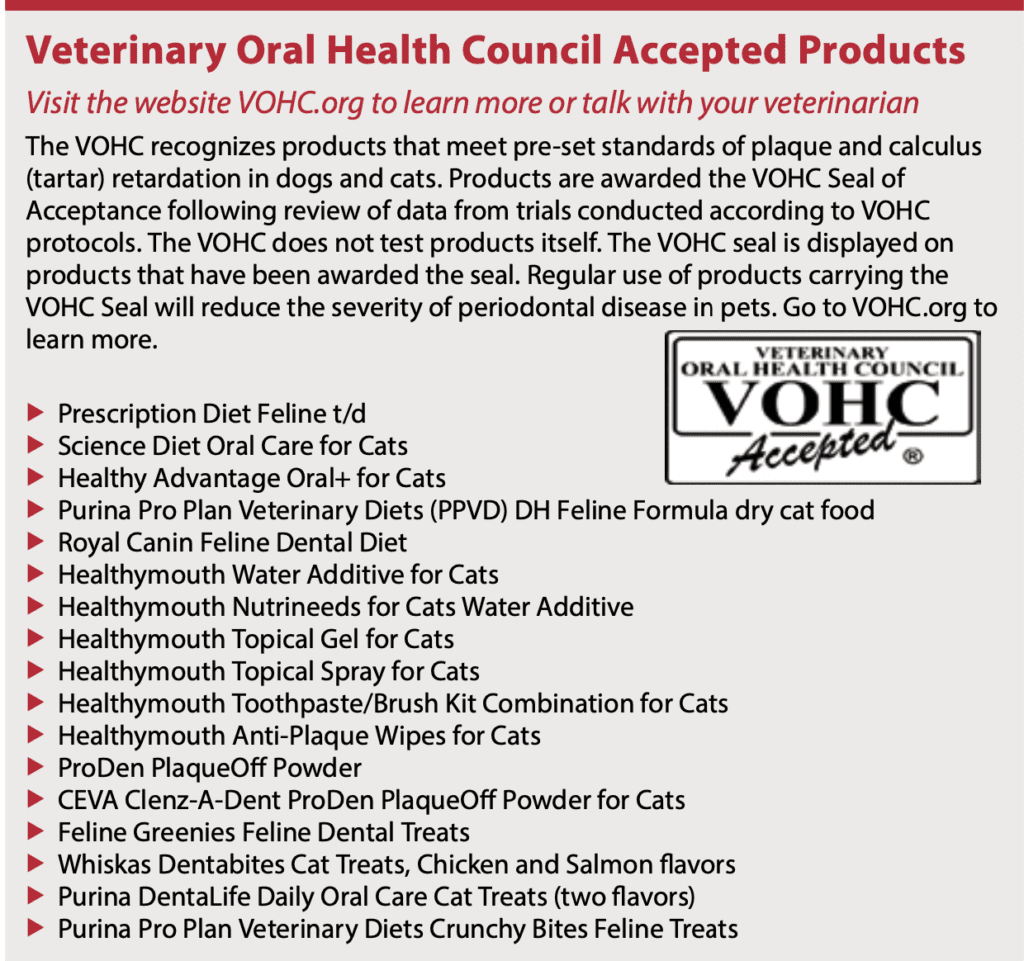
If your cat is turned off by a water additive, this can also become a major health concern. If your cat suffers from kidney disease or lower urinary tract disease (diseases in which drinking enough water is essential), for example, reluctance to drink due to an additive can be detrimental to her health.
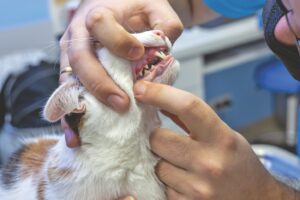
Note the dark red area on the cat’s gums just above her teeth, which indicates gingivitis. And, just like in our own mouths, this is a warning sign that dental disease is setting in.
Bottom Line
Be sensible, work with your veterinarian, and remember that good oral hygiene is an important aspect of managing your cat’s overall health. Home dental care should begin as soon as your kitten’s adult teeth are in, and periodontal assessment and treatment should be provided as directed by your veterinarian. When it comes to home dental care, be patient, be gentle, and be creative to get it done (did we say patient?). Remember, your goal, and the gold standard of home dental care, is daily brushing with a VOHC-approved enzymatic veterinary toothpaste.

